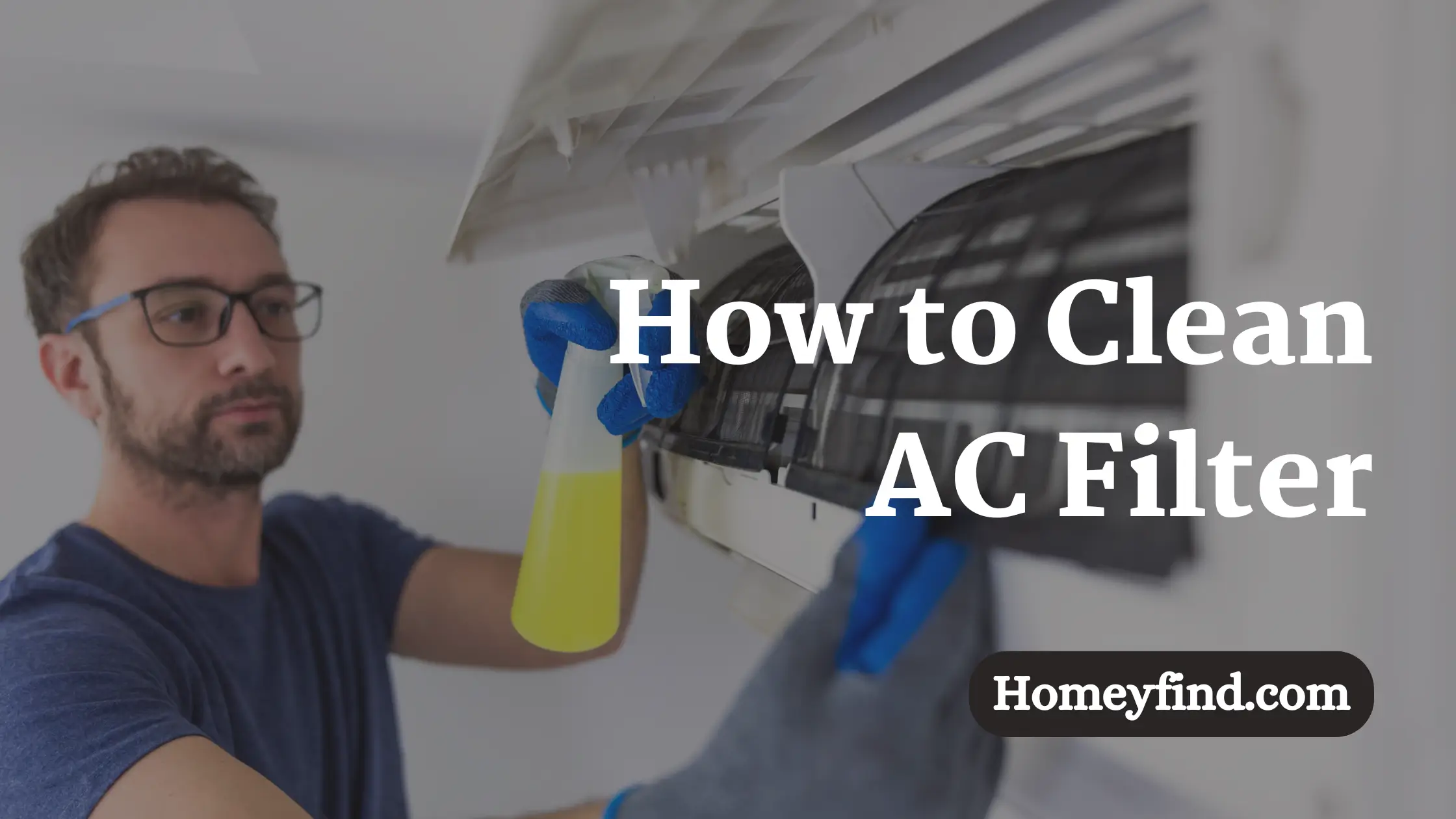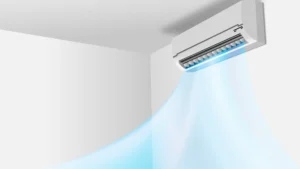Call us: (863) 983-8465
How to Clean AC Filter in 8 Simple Steps

What Is The Purpose Of An AC Filter?

An AC filter plays an important role in your air conditioning system. Its main job is to trap dust, dirt, and other particles from the air before it gets blown into your home. This helps keep the air in your home clean and prevents these particles from clogging up your air conditioner. By keeping the air clean and the system clear, the filter helps your AC run efficiently and prolong its lifespan.
Why Should You Clean Your AC Filter?

Cleaning your AC filter is important for several reasons:
- Improves Air Quality: A clean filter helps remove dust, pollen, and other particles from the air, making it fresher and healthier for you and your family.
- Boosts Efficiency: When the filter is clean, your air conditioner doesn’t have to work as hard to pull air through. This can help reduce energy use and lower your electricity bills.
- Prevents Damage: A clogged filter can cause your AC system to overheat and become damaged. Regular cleaning helps avoid potential repairs and keeps your system running smoothly.
- Extends Equipment Life: Keeping the filter clean helps your air conditioner operate efficiently, which can extend its lifespan and save you money on replacements.
Regularly cleaning or replacing the filter ensures your AC system stays in good condition and provides comfortable, clean air.
Types of AC Filters

There are several types of AC filters, each with its own features and benefits:
1. Fiberglass Filters:
- Description: These are basic filters made of layered fiberglass.
- Benefits: Inexpensive and good for catching large particles like dust and lint.
- Drawbacks: Not very effective at trapping smaller particles or allergens.
2. Pleated Filters:
- Description: These filters have a pleated design that increases the surface area for capturing particles.
- Benefits: Better at trapping smaller particles and lasts longer than fiberglass filters.
- Drawbacks: It can be more expensive than basic filters.
3. HEPA Filters:
- Description: High-efficiency particulate Air (HEPA) filters are designed to capture very small particles, including allergens.
- Benefits: Highly effective at removing dust, pollen, mold, and other tiny particles from the air.
- Drawbacks: These can be more costly and may require a special AC unit to accommodate them.
4. Washable Filters:
- Description: These filters can be cleaned and reused.
- Benefits: Cost-effective because they don’t need to be replaced frequently.
- Drawbacks: Requires regular cleaning and maintenance to remain effective.
5. Electrostatic Filters:
- Description: These filters use a static charge to pull in and trap particles.v
- Benefits: Effective at trapping dust, pollen, and other particles.
- Drawbacks: It may need to be cleaned regularly and can be more expensive than standard filters.
Each type of filter has its own advantages, so choosing the right one depends on your needs and the type of air conditioning system you have.
When Should You Clean or Replace Your AC Filter?

Here are some clear signs that your AC filter needs attention:
- Visible Dirt or Dust: If you can see dust, dirt, or other debris on the filter, it’s time to clean or replace it.
- Reduced Airflow: If you notice weaker airflow from your vents, a clogged filter might be the cause.
- Increased Energy Bills: A dirty filter can make your AC work harder, which can lead to higher energy bills.
- Strange Noises: Unusual sounds from your air conditioner could indicate a problem with the filter or other parts of the system.
- Unpleasant Odors: If you smell musty or unpleasant odors coming from your AC, it could be due to a dirty filter.
- Allergy Symptoms: If you or your family members start experiencing more allergies or respiratory issues, a dirty filter might be affecting air quality.
- Frequent AC Cycling: If your AC turns on and off more frequently than usual, it might be struggling with a clogged filter.
Regularly checking your filter and addressing these signs can help keep your air conditioning system running efficiently and improve indoor air quality.
What You Need to Know Before Cleaning Your AC Filter
1. Turn Off the AC System:
- Always switch off your air conditioner before you start cleaning the filter. This keeps you safe and avoids any accidental damage.
2. Check the Filter Type:
- Washable Filters: Just rinse them with water and a little soap.
- Disposable Filters: Need to be replaced with a new one.
3. Gather Supplies:
- For cleaning: you’ll need a vacuum cleaner, mild soap, water, and a soft brush.
- For replacement: make sure you have the correct size and type of filter ready.
4. Locate the Filter:
- Find where the filter is in your AC unit. It’s usually in the air handler or where the return air duct connects.
5. Understand the Cleaning Method:
- For Washable Filters: Vacuum off dust, wash with soap and water, and let it dry completely.
- For Disposable Filters: Simply remove the old filter and insert a new one.
6. Check for Other Issues:
- While cleaning the filter, look for any visible damage or problems with the AC unit that might need professional attention.
7. Follow Manufacturer Instructions:
- Always refer to your AC unit’s manual for specific recommendations on filter maintenance and cleaning.
What You’ll Need
For Cleaning:
- Vacuum Cleaner: Use it to suck up loose dust and dirt from the filter.
- Mild Soap: For washing the filter. Avoid harsh chemicals.
- Water: To mix with the soap and rinse the filter.
- Soft Brush: To gently scrub the filter if needed.
- Towel or Cloth: To dry the filter after washing.
For Replacement:
- New Filter: Ensure you have the correct size and type of replacement filter for your AC unit. Check the manufacturer’s specifications.
Additional Items:
- Protective Gloves: Optional, to keep your hands clean and protected.
- Step Ladder: If the filter is located in a hard-to-reach area.
How to clean AC Filter

Step1. Turning Off the Air Conditioner
Before you start cleaning your AC filter, make sure to turn off the air conditioner. This step is crucial to avoid any electrical hazards and to ensure you don’t accidentally damage the system while working on it. Switching off the unit also prevents any dust or debris from being blown around while you clean.
Step2. Removing the Filter
Locate the filter in your AC unit, typically found in the air handler or near the return air duct. Carefully remove the filter, taking care not to damage it or the surrounding components. Note the filter’s orientation so you can reinstall it correctly later.
Step3. Vacuuming the Filter
Use a vacuum cleaner with a brush attachment to gently remove dust and dirt from the filter. This step helps to get rid of loose debris and makes the subsequent cleaning process more effective. Handle carefully to avoid tearing the filter.
Step4. Washing the Filter
If your filter is washable, fill a bucket with water and add a small amount of mild soap. Dip a soft brush or cloth into the soapy water and gently scrub the filter to remove any remaining dirt. Avoid using harsh chemicals, as they can damage the filter.
Step5. Rinsing the Filter
After scrubbing, rinse the filter thoroughly with clean water to remove all soap and debris. Keep rinsing until the water is clear. This step ensures that no soap residue is left behind, which could affect the filter’s performance.
Step6. Drying the Filter
Allow the filter to air dry completely before putting it back into the AC unit. This is important because a wet filter can lead to mold growth or damage the unit. Place the filter in a well-ventilated area to speed up the drying process.
Step7. Reinstalling the Filter
Once the filter is fully dry, carefully reinstall it into its original slot in the AC unit. Ensure it is properly aligned and fits snugly. Proper installation is key to maintaining good airflow and system efficiency.
Step8. Turning the AC Back On
After the filter is reinstalled, turn the air conditioner back on. Check to ensure that the system is running smoothly and that the airflow is consistent. This confirms that the filter is correctly in place and functioning properly.
If you need expert help with your air conditioning system, HomeyFind is here for you! Our skilled professionals are ready to tackle any issues and ensure your AC runs smoothly. Don’t wait for problems to get worse—call us now or visit our website for more information and to schedule your service today! Have you tried cleaning your AC filter or other parts? Share your experience, tips, or any questions you have. Engaging with others can provide additional insights and help you maintain your system effectively. Happy cleaning and enjoy a well-maintained air conditioner! It’s recommended to clean or replace your AC filter every 1-3 months. The frequency can vary based on usage, dust levels, and filter type. Not all filters are washable. Check the manufacturer’s instructions for your specific filter type. Disposable filters should be replaced, while washable ones can be cleaned. If you experience persistent issues such as strange noises, reduced cooling efficiency, or electrical problems, it’s best to call a professional.
1. Coils:
2. Vents and Ducts:
3. Drain Pan and Drain Line:
4. Blower Fan:
5. Cabinet and Housing:


Q1. How often should I clean my AC filter?
Q2. Can I clean any type of AC filter?
Q3. How do I know if my AC system needs professional help?




